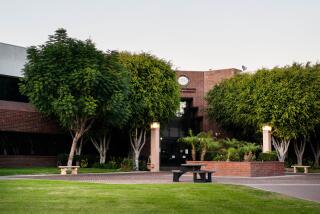2 S.D. Research Facilities to Share $6.5 Million : Medicine: Scripps Research Institute and La Jolla Cancer Research Foundation win foundation grants.
- Share via
A prestigious national foundation granted $6.5 million to two San Diego research institutions, officials announced Friday.
The Scripps Research Institute received a $5-million gift, its largest ever from a private foundation, to research how cells function, which the institute believes could lead to disease-resistant crops and drugs to combat heart disease and cancer.
And the La Jolla Cancer Research Foundation received $1.5 million to study how cancer-causing cells travel through the body. With this knowledge, researchers hope to be able to prevent cancer from spreading.
The five-year grants were awarded by the Lucille Markey Charitable Trust, a Florida-based foundation that awards money for biomedical research. On Friday, Markey officials announced the two San Diego grants and a $4 million grant to Cornell University Medical College.
Last month, the foundation awarded $4 million to set up a training program for graduate students at the UC San Diego.
“San Diego is doing very, very well,” said Terry Gach, spokesman for the La Jolla Cancer Research Foundation.
At Scripps, the money will be used to support an unusual interdisciplinary approach to cell research that unites the efforts of three teams of experts: biologists, chemists and molecular bio-physicists. With this approach, the biologists identify a structure, the chemists decode it and the third group of experts create a three-dimensional model.
“It’s important that we go way beyond our own discipline if we want to try and get answers,” said Norton B. Gilula, chairman of Scripps’ cell biology department and principal investigator for the programs funded by the Markey grant.
The interdisciplinary approach at Scripps kicked into gear two years ago when the institute began aggressively recruiting chemists. For Scripps, which is well-known for its work in immunology, the Markey grant was an “important signal” that the institution is expanding its knowledge and its prominence, Gilula said.
Scientists will use the Markey money to focus on three major areas: how cells communicate, divide, and regulate themselves.
With a greater knowledge of these basic functions, doctors would be able to interrupt some of the actions that cause diseases such as cancer. If doctors better understood how the cells divide, they would be able to block the unregulated division of cells that occurs with leukemia patients.
Breakthroughs in cell biology also would be applicable in other fields, such as applying biotechnology to create disease-resistants crops, Gilula said.
At the La Jolla Cancer Research Foundation, scientists will use the Markey grant to study how cells attach to tissue structures, a process that allows cancer cells to migrate throughout the body.
In 1983, Erkki Ruoslahti, the foundation’s president, discovered small pieces of protein, or peptides, that acted like glue. Scientists soon realized that this peptide could also act as a decoy, luring cells and getting them to anchor on the synthetic model.
Medications using this peptide are being developed to help accelerate the healing of wounds. Scientists believe the peptide might also be helpful in getting transplanted organs to bond to tissues. Ruoslahti is also optimistic that it can be used to combat cancer.
With the Markey grant, Ruoslahti and others will study whether a similarly acting, adhesive-like peptide could be used to prevent cancer from spreading by fooling cancer cells into adhering to a decoy rather than tissue.
To do this, they will create three-dimensional models of cells, studying what signals cells give and how cells might be tricked, Ruoslahti said.
Progress with drugs to battle cancer is slow, he cautioned. Unlike wound-healing or blood clotting medications, cancer drugs must be studied in patients for at least five years, he said.
“We have a lot of work to do before we can use this as a drug to treat patients,” Ruoslahti said. “I don’t want people to think we have something and get their hopes up. But we are working very hard.”






